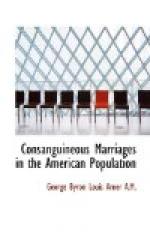[Footnote 2: Maine, Early Law and Custom, p. 228.]
Much space is given to the alleged “innate horror of incest,” and frequent appeals are made to Scripture, wrongly assuming that the marriage of cousins is prohibited in the Mosaic Law.
The origin of “prohibited degrees” is only conjectural. The Christian Church apparently borrowed its prohibitory canons from the Roman Law,[3] and a dispensation is still necessary before a Catholic can marry his first cousin. However, such dispensations have always been easy to obtain, especially by royal families, and even the marriage of uncle and niece sometimes occurs, as among the Spanish Habsburgs, and as recently as 1889 in the House of Savoy.
[Footnote 3: Luckock, History of Marriage, p. 282.]
The prohibition of the marriage of first cousins was removed in England by the Marriage Act of 1540,[4] but by this time the idea of the harmfulness of kinship marriage was so thoroughly impressed upon the people that they were very prone to look askance at such unions, and if they were followed by any defective progeny, the fact would be noted, and looked upon as a chastisement visited upon the parents for their sin. Naturally the idea became proverbial, and in some places it has influenced the civil law.
[Footnote 4: Child, “On Marriages of Consanguinity,” in Medico-Chirurgical Review, April, 1862, p. 469.]
Perhaps the first printed discussion of the subject in America is from the pen of Noah Webster, in an essay which should be as interesting to the spelling reformer as to the sociologist.[5] He writes: “It iz no crime for brothers and sisters to intermarry, except the fatal consequences to society; for were it generally practised, men would become a race of pigmies. It iz no crime for brothers’ and sisters’ children to intermarry, and this iz often practised; but such near blood connections often produce imperfect children. The common peeple hav hence drawn an argument to proov such connections criminal; considering weakness, sickness and deformity in the offspring az judgements upon the parents. Superstition iz often awake when reezon iz asleep.”
[Footnote 5: Webster, Collection of Essays and Fugitiv Writings on Moral, Historical, Political and Religious Subjects, 1790, p. 322.]
From about 1855 to 1880 much was written about the effect of consanguineal interbreeding. One of the first contributions came from America. In 1858 Dr. S.M. Bemiss, of Louisville, Kentucky, reported to the American Medical Association the results of his investigation of 833 cases of consanguineous marriage.[6] His compilation remains to this day the largest single piece of direct statistical work on the subject. Unfortunately, however, his statistics have a strong, if unintentional, bias which seriously affects their value. In France one of the earliest discussions was by M. Boudin,[7] who evidently obtained




